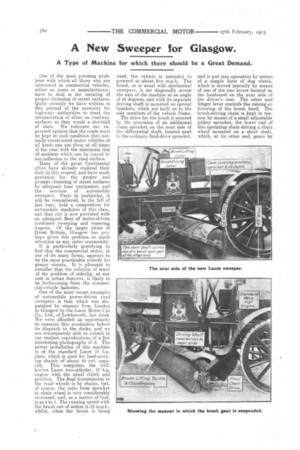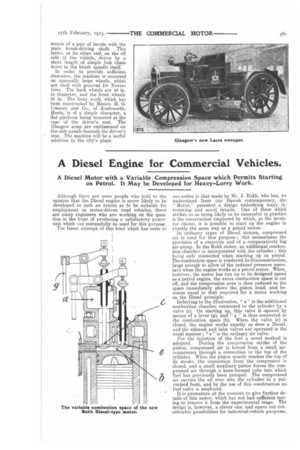A New Sweeper for Glasgow.
Page 6

Page 7

If you've noticed an error in this article please click here to report it so we can fix it.
A Type of Machine for which there should be a Great Demand.
One of the most pressing problems with which all those who are interested in commercial vehicles, either as users or manufacturers, have to deal is the securing of proper cleansing of street surfaces. Quite recently we have written in this journal of the necessity for highways authorities to treat the accumulation of slime 011 roadway surfaces as they would a downfall of snow. We reiterate our expressed opinion that the roads must be kept in such condition that normally-constructed motor vehicles of all kinds can use them at all times of the year with the mimimum risk of accident which can be traced to non-adhesion to the road surface.
Many of the great Continental cities have already realized their duty in this respect, and have made provision for the proper and prompt cleansing of street surfaces by adequate hose equipment, and the services of automobile sweepers. Paris in particular, it will be remembered, in the fall of last year, held a competition for automobile machines of this class, and that city is now provided with an adequate fleet of motor-driven combined sweeping and watering wagons. Of the larger cities of Great Britain, Glasgow has perhaps given this problem as much attention as any sister community.
It is particularly gratifying to find that the commercial motor, in one of its many forms, appears to be the most practicable remedy for greasy streets. It is pleasant to consider that the solution of much of the problem of sideslip, at any rate in urban districts, is likely to be forthcoming from the commercial-vehicle factories.
One of the most recent examples of automobile power-driven road sweepers is that which was dispatched by steamer from London to Glasgow by the Laere Motor Car Co.., Ltd., of Letchworth, last week. We were afforded an opportunity to examine this production before its dispatch to the docks, and we are consequently able to submit to our readers reproductions of a few interesting photographs of it. The power installation of this machine is of the standard Lacre 18 h,p. class, which is used for load-carrying chassis of about 30 cwt. capacity. This comprises the wellknown Lacre two-cylinder, 18 h.p. engine with the usual clutch and gearbox. The final transmission to the road wheels is by chains, but, of course, the ratio from sprocket to chain wheel is very considerably increased, and, as a matter of fact, is as 4 to 1. The running speed with the brush out of action is 12 m.p.h., whilst, when the brush is being
used, the vehicle is intended to proceed at about five m.p.h.. The brush, as is usual with mechanical sweepers, is set diagonally across the axis of the machine at an angle of 45 degrees, and with its separate driving shaft is mounted on special brackets, which are built on to the side members of the vehicle frame.
The drive for the brush is secured by the provision of an additional chain sprocket on the near side of the differential shaft, located next to the ordinary final-drive sprocket. and is put into operation by means of a simple form of dog clutch,. which is moved laterally by means. of one of the two levers located on the footboard on the near side of the driver's seat. The other and longer lever controls the raising orlowering of the brush itself. The brush-driving chain is kept in tension by means of a enaall adjustable jockey sprocket, the lower end of this operating chain driving a chain wheel mounted on a short shaft, which, at its other end, gears by means of a pair of bevels with the main brush-driving shaft.. This latter, at its other end, on the off side of the vehicle, drives by a short length of simple link chain down to the brush spindle itself.
In order to provide sufficient clearance, the machine is mounted on unusually large wheels, which are shod with grooved De Nevers tires. The back wheels are 48 in. in diameter, and the front wheels 38 in. The body work, which has been constructed by Messrs. H. G. Creasey and Co., of Enebworth, Hertz, is of a. simple character, a flat platform being mounted at the. rear of the driver's seat. The Glasgow arms are emblazoned on the side-panels beneath the driver's Seat. The machine will be a useful addition to the city's plant.


























































































